
Carbon dioxide is a chemical compound with the chemical formula CO2. It is made up of molecules that each have one carbon atom covalently double bonded to two oxygen atoms. It is found in the gas state at room temperature, and as the source of available carbon in the carbon cycle, atmospheric CO2 is the primary carbon source for life on Earth. In the air, carbon dioxide is transparent to visible light but absorbs infrared radiation, acting as a greenhouse gas. Carbon dioxide is soluble in water and is found in groundwater, lakes, ice caps, and seawater. When carbon dioxide dissolves in water, it forms carbonate and mainly bicarbonate, which causes ocean acidification as atmospheric CO2 levels increase.

The Miller–Urey experiment (or Miller experiment) was an experiment in chemical synthesis carried out in 1952 that simulated the conditions thought at the time to be present in the atmosphere of the early, prebiotic Earth. It is seen as one of the first successful experiments demonstrating the synthesis of organic compounds from inorganic constituents in an origin of life scenario. The experiment used methane (CH4), ammonia (NH3), hydrogen (H2), in ratio 2:2:1, and water (H2O). Applying an electric arc (the latter simulating lightning) resulted in the production of amino acids.
Nitrogen fixation is a chemical process by which molecular dinitrogen is converted into ammonia. It occurs both biologically and abiologically in chemical industries. Biological nitrogen fixation or diazotrophy is catalyzed by enzymes called nitrogenases. These enzyme complexes are encoded by the Nif genes and contain iron, often with a second metal.

The carbon cycle is that part of the biogeochemical cycle by which carbon is exchanged among the biosphere, pedosphere, geosphere, hydrosphere, and atmosphere of Earth. Other major biogeochemical cycles include the nitrogen cycle and the water cycle. Carbon is the main component of biological compounds as well as a major component of many minerals such as limestone. The carbon cycle comprises a sequence of events that are key to making Earth capable of sustaining life. It describes the movement of carbon as it is recycled and reused throughout the biosphere, as well as long-term processes of carbon sequestration (storage) to and release from carbon sinks.

Lightning is a natural phenomenon formed by electrostatic discharges through the atmosphere between two electrically charged regions, either both in the atmosphere or one in the atmosphere and one on the ground, temporarily neutralizing these in a near-instantaneous release of an average of between 200 megajoules and 7 gigajoules of energy, depending on the type. This discharge may produce a wide range of electromagnetic radiation, from heat created by the rapid movement of electrons, to brilliant flashes of visible light in the form of black-body radiation. Lightning causes thunder, a sound from the shock wave which develops as gases in the vicinity of the discharge experience a sudden increase in pressure. Lightning occurs commonly during thunderstorms as well as other types of energetic weather systems, but volcanic lightning can also occur during volcanic eruptions. Lightning is an atmospheric electrical phenomenon and contributes to the global atmospheric electrical circuit.
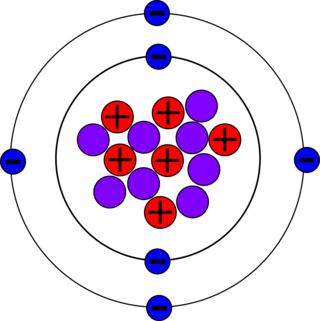
Carbon-14, C-14, 14
C or radiocarbon, is a radioactive isotope of carbon with an atomic nucleus containing 6 protons and 8 neutrons. Its presence in organic materials is the basis of the radiocarbon dating method pioneered by Willard Libby and colleagues (1949) to date archaeological, geological and hydrogeological samples. Carbon-14 was discovered on February 27, 1940, by Martin Kamen and Sam Ruben at the University of California Radiation Laboratory in Berkeley, California. Its existence had been suggested by Franz Kurie in 1934.

An atmosphere is a layer of gasses that envelop an astronomical object, held in place by the gravity of the object. A planet retains an atmosphere when the gravity is great and the temperature of the atmosphere is low. A stellar atmosphere is the outer region of a star, which includes the layers above the opaque photosphere; stars of low temperature might have outer atmospheres containing compound molecules.

Paleomagnetism is the study of prehistoric Earth's magnetic fields recorded in rocks, sediment, or archeological materials. Geophysicists who specialize in paleomagnetism are called paleomagnetists.
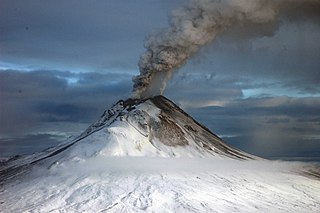
Volcanic gases are gases given off by active volcanoes. These include gases trapped in cavities (vesicles) in volcanic rocks, dissolved or dissociated gases in magma and lava, or gases emanating from lava, from volcanic craters or vents. Volcanic gases can also be emitted through groundwater heated by volcanic action.

The atmosphere of Venus is the very dense layer of gasses surrounding the planet Venus. Venus's atmosphere is composed of 96.5% carbon dioxide and 3.5% nitrogen, with other chemical compounds present only in trace amounts. It is much denser and hotter than that of Earth; the temperature at the surface is 740 K, and the pressure is 93 bar (1,350 psi), roughly the pressure found 900 m (3,000 ft) under water on Earth. The atmosphere of Venus supports decks of opaque clouds of sulfuric acid that cover the entire planet, preventing optical Earth-based and orbital observation of the surface. Information about surface topography has been obtained exclusively by radar imaging.
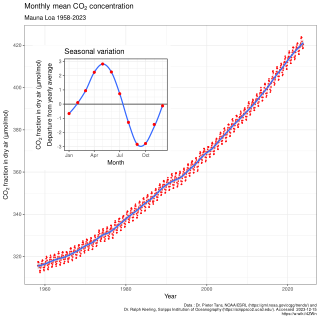
In Earth's atmosphere, carbon dioxide is a trace gas that plays an integral part in the greenhouse effect, carbon cycle, photosynthesis and oceanic carbon cycle. It is one of three main greenhouse gases in the atmosphere of Earth. Water vapor is the primary greenhouse gas, as of 2010, contributing 50% of the greenhouse effect, followed by carbon dioxide at 20%. The current global average concentration of carbon dioxide in the atmosphere is 421 ppm (0.04%) as of May 2022. This is an increase of 50% since the start of the Industrial Revolution, up from 280 ppm during the 10,000 years prior to the mid-18th century. The increase is due to human activity.

Magnetofossils are the fossil remains of magnetic particles produced by magnetotactic bacteria (magnetobacteria) and preserved in the geologic record. The oldest definitive magnetofossils formed of the mineral magnetite come from the Cretaceous chalk beds of southern England, while magnetofossil reports, not considered to be robust, extend on Earth to the 1.9-billion-year-old Gunflint Chert; they may include the four-billion-year-old Martian meteorite ALH84001.
A paleoatmosphere is an atmosphere, particularly that of Earth, at some unspecified time in the geological past.

Greenhouse gases (GHGs) are the gases in the atmosphere that raise the surface temperature of planets such as the Earth. What distinguishes them from other gases is that they absorb the wavelengths of radiation that a planet emits, resulting in the greenhouse effect. The Earth is warmed by sunlight, causing its surface to radiate heat, which is then mostly absorbed by greenhouse gases. Without greenhouse gases in the atmosphere, the average temperature of Earth's surface would be about −18 °C (0 °F), rather than the present average of 15 °C (59 °F).
Soil gases are the gases found in the air space between soil components. The spaces between the solid soil particles, if they do not contain water, are filled with air. The primary soil gases are nitrogen, carbon dioxide and oxygen. Oxygen is critical because it allows for respiration of both plant roots and soil organisms. Other natural soil gases include nitric oxide, nitrous oxide, methane, and ammonia. Some environmental contaminants below ground produce gas which diffuses through the soil such as from landfill wastes, mining activities, and contamination by petroleum hydrocarbons which produce volatile organic compounds.
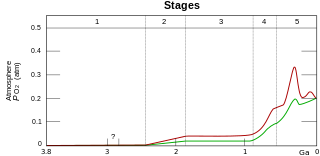
Before photosynthesis evolved, Earth's atmosphere had no free diatomic oxygen (O2). Small quantities of oxygen were released by geological and biological processes, but did not build up in the atmosphere due to reactions with reducing minerals.
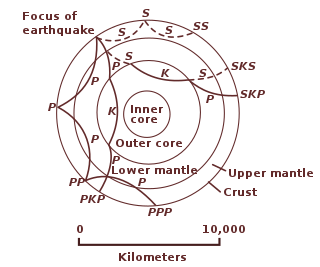
The following outline is provided as an overview of and topical guide to geophysics:

The atmospheric carbon cycle accounts for the exchange of gaseous carbon compounds, primarily carbon dioxide, between Earth's atmosphere, the oceans, and the terrestrial biosphere. It is one of the faster components of the planet's overall carbon cycle, supporting the exchange of more than 200 billion tons of carbon in and out of the atmosphere throughout the course of each year. Atmospheric concentrations of CO2 remain stable over longer timescales only when there exists a balance between these two flows. Methane, Carbon monoxide (CO), and other human-made compounds are present in smaller concentrations and are also part of the atmospheric carbon cycle.

The oceanic carbon cycle is composed of processes that exchange carbon between various pools within the ocean as well as between the atmosphere, Earth interior, and the seafloor. The carbon cycle is a result of many interacting forces across multiple time and space scales that circulates carbon around the planet, ensuring that carbon is available globally. The Oceanic carbon cycle is a central process to the global carbon cycle and contains both inorganic carbon and organic carbon. Part of the marine carbon cycle transforms carbon between non-living and living matter.

The prebiotic atmosphere is the second atmosphere present on Earth before today's biotic, oxygen-rich third atmosphere, and after the first atmosphere of Earth's formation. The formation of the Earth, roughly 4.5 billion years ago, involved multiple collisions and coalescence of planetary embryos. This was followed by a <100 million year period on Earth where a magma ocean was present, the atmosphere was mainly steam, and surface temperatures reached up to 8,000 K (14,000 °F). Earth's surface then cooled and the atmosphere stabilized, establishing the prebiotic atmosphere. The environmental conditions during this time period were quite different from today: the Sun was ~30% dimmer overall yet brighter at ultraviolet and x-ray wavelengths, there was a liquid ocean, it is unknown if there were continents but oceanic islands were likely, Earth's interior chemistry was different, and there was a larger flux of impactors hitting Earth's surface.

















